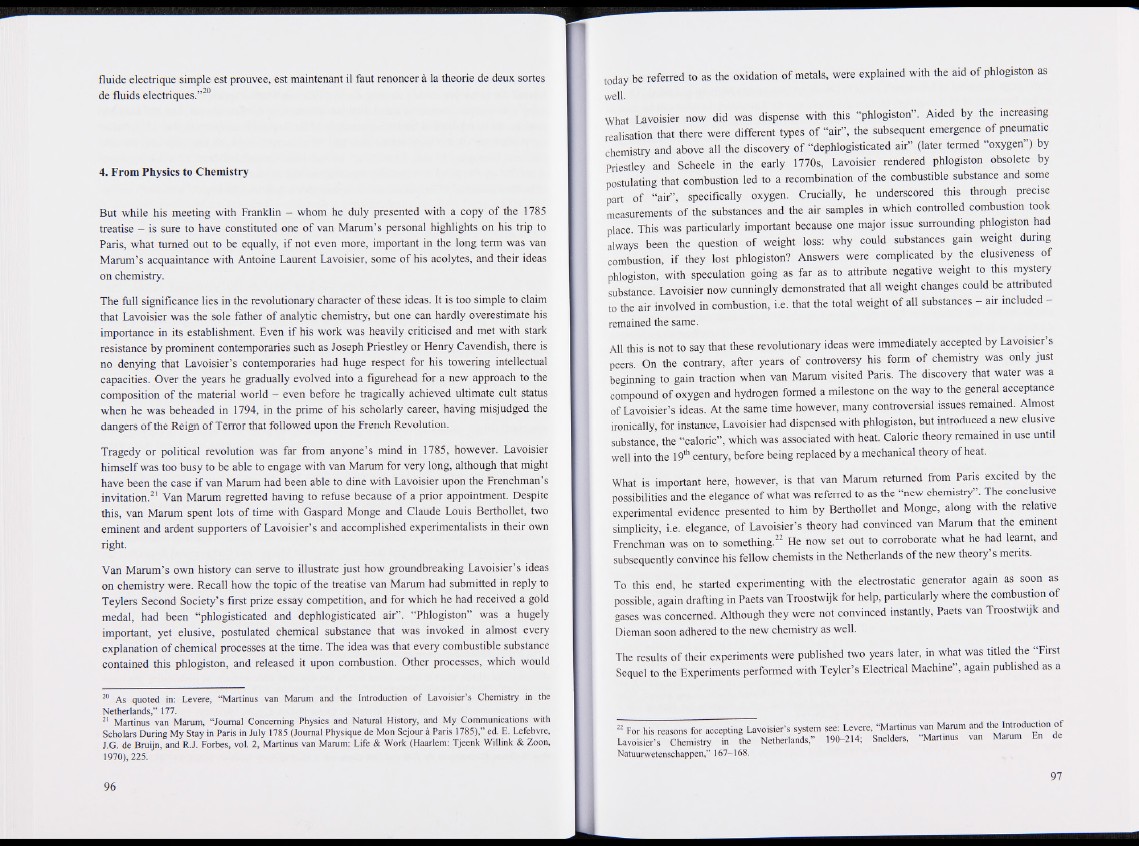
fluide electrique simple est prouvée, est maintenant il faut renoncer à la théorie de deux sortes
de fluids électriques.”2
4. From Physics to Chemistry
But while his meeting with Franklin - whom he duly presented with a copy of the 1785
treatise^; is sure to have constituted one of van Marum’s personal highlights on his trip to
Paris, what turned out to be equally, if not even more, important in the long term was van
Marum’s acquaintance with Antoine Laurent Lavoisier, some of his acolytes, and their ideas
on chemistry.
The full significance lies in the revolutionary character of these ideas. It is too simple to claim
that Lavoisier was the sole father of analytic chemistry, but one can hardly overestimate his
importance in its establishment. Even if his work was heavily criticised and met with stark
resistance by prominent contemporaries such as Joseph Priestley or Henry Cavendish, there is
no denying that Lavoisier’s contemporaries had huge respect for his towering intellectual
capacities. Over the years he gradually evolved into a figurehead for a new approach to the
composition of the material world - even before he tragically achieved ultimate cult status
when he was beheaded in 1794, in the prime of his scholarly career, having misjudged the
dangers of the Reign of Terror that followed upon the French Revolution.
Tragedy or political revolution was far from anyone’s mind in 1785, however. Lavoisier
himself was too busy to be able to engage with van Marum for very long, although that might
have been the case if van Marum had been able to dine with Lavoisier upon the Frenchman’s
invitation.21 Van Marum regretted having to refuse because of a prior appointment. Despite
this, van Marum spent lots of time with Gaspard Monge and Claude Louis Berthollet, two
eminent and ardent supporters of Lavoisier’s and accomplished experimentalists in their own
right.
Van Marum’s own history can serve to illustrate just how groundbreaking Lavoisier’s ideas
on chemistry were. Recall how the topic of the treatise van Marum had submitted in reply to
Teylers Second Society’s first prize essay competition, and for which he had received a gold
medal, had been “phlogisticated and dephlogisticated air”. “Phlogiston” was a hugely
important, yet elusive, postulated chemical substance that was invoked in almost every
explanation of chemical processes at the time. The idea was that every combustible substance
contained this phlogiston, and released it upon combustion. Other processes, which would
20 As quoted in: Levere, “Martinus van Marum and the Introduction o f Lavoisier’s Chemistry in the
Netherlands,” 177.
21 Martinus van Marum, “Journal Concerning Physics and Natural History, and My Communications with
Scholars During My Stay in Paris in July 1785 (Journal Physique de Mon Sejour a Paris 1785),” ed. E. Lefebvre,
J.G. de Bruijn, and R.J. Forbes, vol. 2, Martinus van Marum: Life & Work (Haarlem: Tjeenk Willink & Zoon,
1970), 225.
today be referred to as the oxidation of metals, were explained with the aid of phlogiston as
well-
What Lavoisier now did was dispense with this “phlogiston”. Aided by the increasing
realisation that there were different types of “air”, the subsequent emergence of pneumatic
chemistry and above all the discovery of “dephlogisticated air” (later termed “oxygen”) by
Priestley and Scheele in the early 1770s, Lavoisier rendered phlogiston obsolete by
postulating that combustion led to a recombination of the combustible substance and some
part of “air”, specifically oxygen. Crucially, he underscored this through precise
measurements of the substances and the air samples in which controlled combustion took
place. This was particularly important because one major issue surrounding phlogiston had
always been the question of weight loss: why could substances gain weight during
combustion, if they lost phlogiston? Answers were complicated by the elusiveness of
phlogiston, with speculation going as far as to attribute negative weight to this mystery
substance. Lavoisier now cunningly demonstrated that all weight changes could be attributed
to the air involved in combustion, i.e. that the total weight of all substances A?air include#^
remained the same.
All this is not to say that these revolutionary ideas were immediately accepted by Lavoisier s
peers. On the contrary, after years of controversy his form of chemistry was only just
beginning to gain traction when van Marum visited Paris. The discovery that water was a
compound of oxygen and hydrogen formed a milestone on the way to the general acceptance
of Lavoisier’s ideas. At the same time however, many controversial issues remained. Almost
ironically, for instance, Lavoisier had dispensed with phlogiston, but introduced a new elusive
substance, the “caloric”, which was associated with heat. Caloric theory remained in use until
well into the 19th century, before being replaced by a mechanical theory of heat.
What is important here, however, is that van Marum returned from Paris excited by the
possibilities and the elegance of what was referred to as the “new chemistry” . The conclusive
experimental evidence presented to him by Berthollet and Monge, along with the relative
simplicity, i.e. elegance, of Lavoisier’s theory had convinced van Marum that the eminent
Frenchman was on to something.22 He now set out to corroborate what he had learnt, and
subsequently convince his fellow chemists in the Netherlands of the new theory’s merits.
To this end, he started experimenting with the electrostatic generator again as soon as
possible, again drafting in Paets van Troostwijk for help, particularly where the combustion of
gases was concerned. Although they were not convinced instantly, Paets van Troostwijk and
Dieman soon adhered to the new chemistry as well.
The results of their experiments were published two years later, in what was titled the First
Sequel to the Experiments performed with Teyler’s Electrical Machine”, again published as a
22 For his reasons for accepting Lavoisier’s system see: Levere, “Martinus van Marum and the Introduction o f
Lavoisier’s Chemistry in the Netherlands,” 190-214; Snelders, “Martinus van Marum En de
Natuurwetenschappen,” 167-168.